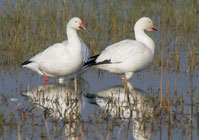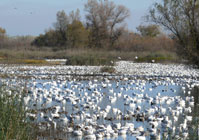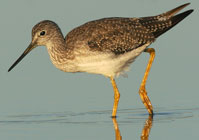Accomplishments
The CVJV partnership has earned an impressive record of accomplishment since its inception in 1988, and is making great progress towards meeting the objectives identified in its 2020 Implementation Plan.

 Central Valley Habitat
Central Valley HabitatThe Central Valley stretches 450 miles down the center of California. It totals approximately 10 million acres, or 10% of the state, and includes portions of 19 counties. The Valley provides some of the most important bird habitat in North America, hosting one of the largest concentrations of migratory birds in the world during the fall and winter. In the 1800s, the Central Valley contained more than 4 million acres of wetland habitats, supporting an estimated 20 to 40 million waterfowl annually. Grassland and riparian habitats once bordered most of these wetlands. Since then, agricultural and urban development have destroyed or modified more than 95% of the historic wetlands and over 90% of all riparian habitats. Today, just over 205,000 acres of managed wetlands remain in the Central Valley, and of those, two thirds are in private ownership.
The efforts of the Central Valley Joint Venture (CVJV) partners to protect, restore, and enhance wetlands have significantly increased wildlife habitat resources in the Central Valley, not only for waterfowl, but for numerous other wetland dependent species as well. Using a collaborative, non-regulatory approach, and guided by the 2006 Implementation Plan, the CVJV will work together to insure that those benefits continue to expand for wildlife and the general public.
The CVJV partnership has earned an impressive record of accomplishment since its inception in 1988, and is making great progress towards meeting the objectives identified in its 2020 Implementation Plan.

Follow these links to learn about some of the important bird conservation work happening in California's Central Valley.
